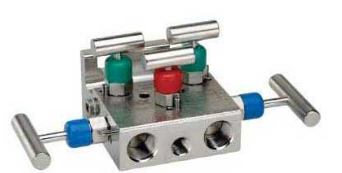What is a Block and Bleed Manifold?
Block and bleed manifolds are a type of valve arrangement used primarily in instrumentation systems to isolate and vent parts of a process for maintenance, calibration, or safety purposes. For example, a block and bleed manifold would be used to stop the flow fluids or gases to some component (pressure gauge or transmitter).

How do Block and Bleed Manifolds Work?
Normal operations of the block and bleed manifolds are as follows:
- The block valves are open and allowing process fluid (gas or liquid) to reach the instrument. In other words, the block valves are allowing the instrument (a pressure gauge or transmitter) to read the pressure cause by the process.
- The block valves are then closed. Thus, the process fluid is prevented from reaching the instrument, resulting in the instrument to be isolated from the high-pressure or hazardous fluid.
- During the isolation there is still pressure trapped between the block valve and the instrument. For this reason, the bleed valve must be opened to vent the trapped fluid safely to the atmosphere or to a drain.
After following these procedures maintenance and calibration can safely be done on the instrumentation.
Type of Block and Bleed Manifolds
Single Block and Bleed
- Configuration: One block valve and one bleed valve.
- Purpose: Basic isolation and venting. To that end, 3-vavle manifolds are commonly used in low-risk applications where full double isolation isn’t needed.
Double Block and Bleed
- Configuration: Two block valves and one bleed valve.
- Purpose: Offers redundancy and higher safety by isolating the process with two block valves. To that end, double block and bleed manifolds are commonly used in high-risk systems like oil and gas or chemical processing.
2-Valve Manifold
- Configuration: One block valve and one bleed valve.
- Purpose: Anywhere that needs isolation and venting. With this in mind, 2-valve manifolds are commonly used with pressure transmitters and gauges.
3-Valve Manifold
- Configuration: Two block valves and one bleed valve.
- Purpose: Equalizing valve balances pressure between high and low sides before zeroing or calibration. For this reason, 3-valve manifolds are commonly used with differential pressure transmitters.
5-Valve Manifold
- Configuration: Two block valves, one equalizer, and two bleed valves.
- Purpose: Allows for isolating, equalizing, and bleeding both high and low sides safely. For this reason, 5-valve manifolds are commonly used in advanced differential pressure application.
Modular Block and Bleed Valves
- Configuration: Combining block, bleed, and sometimes a gauge or drain ports.
- Purpose: Where space-saving and integration are important (e.g. skid-mounted systems)

Where can they be found?
Block and bleed manifolds can be found in throughout various applications and industries. A few examples are, oil & gas applications, chemical & petrochemical plants, power generation stations, water & wastewater treatment facilities, food processing, and refineries.
